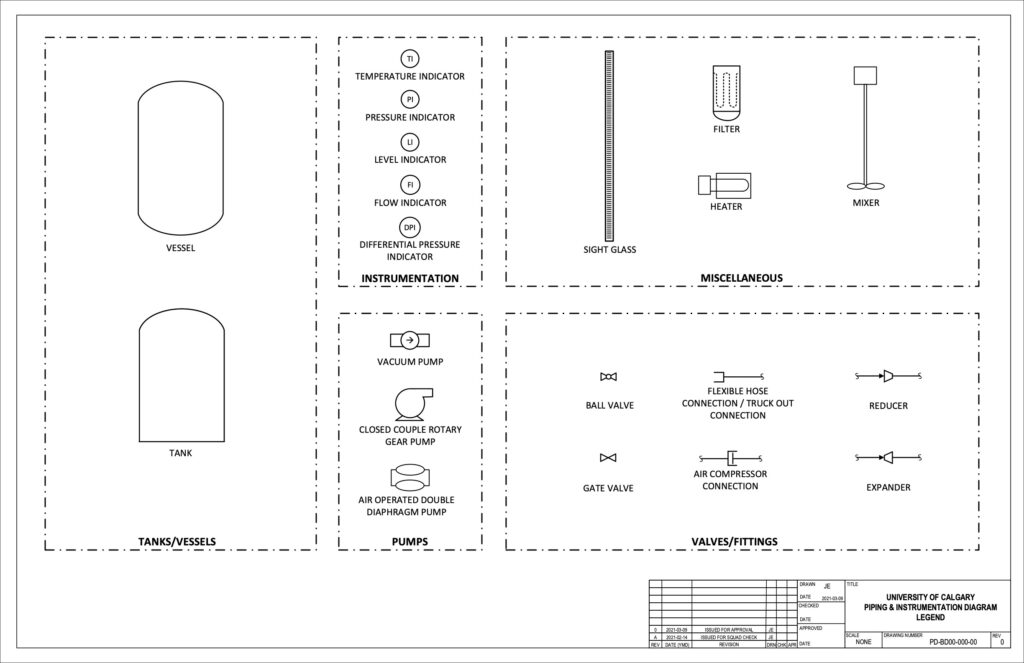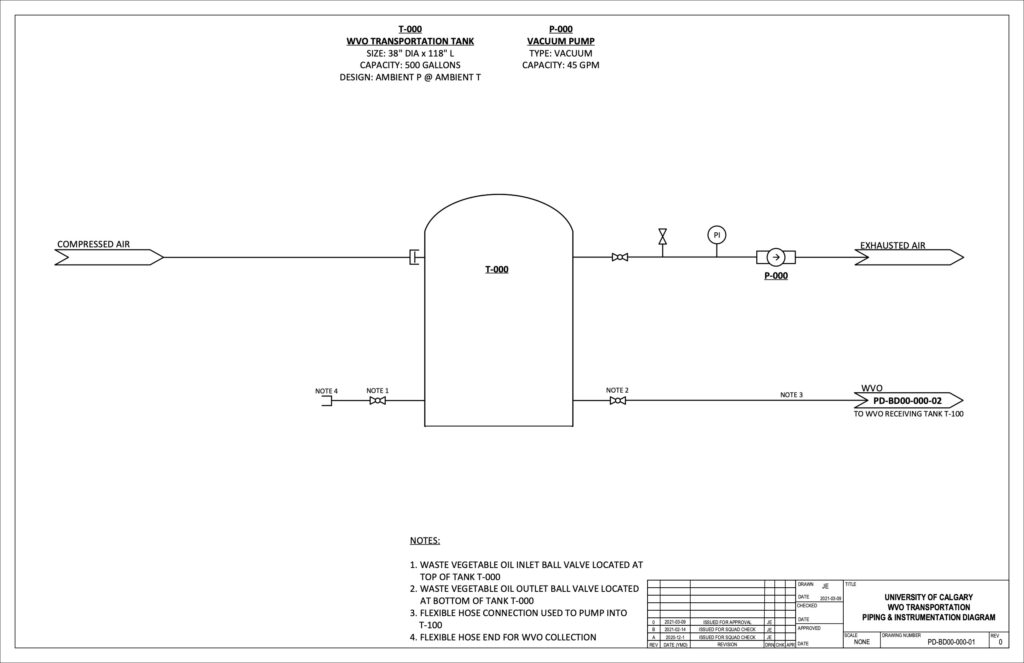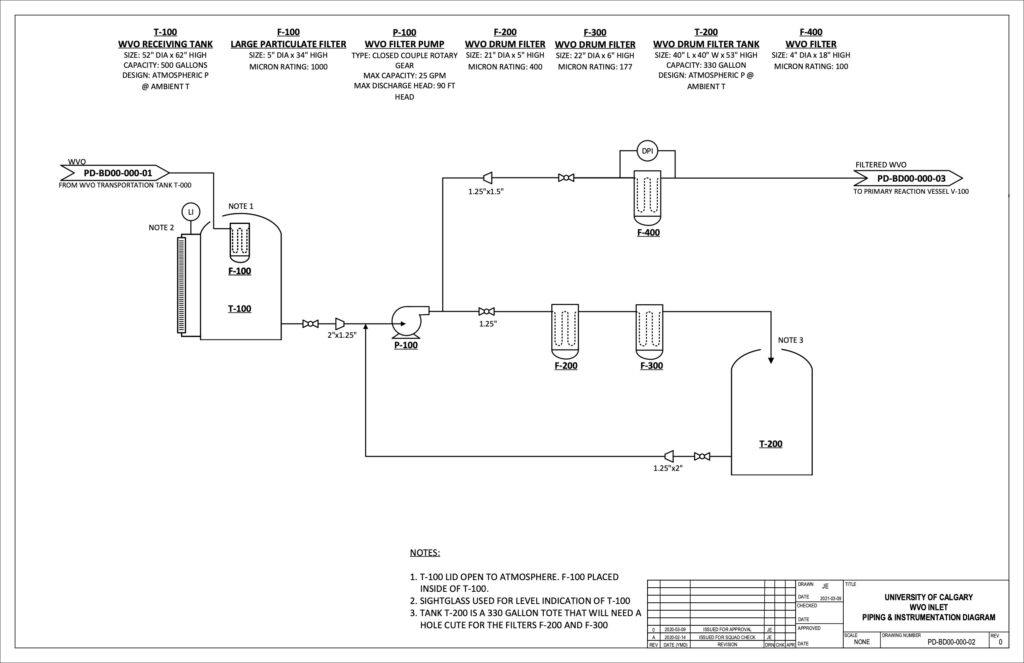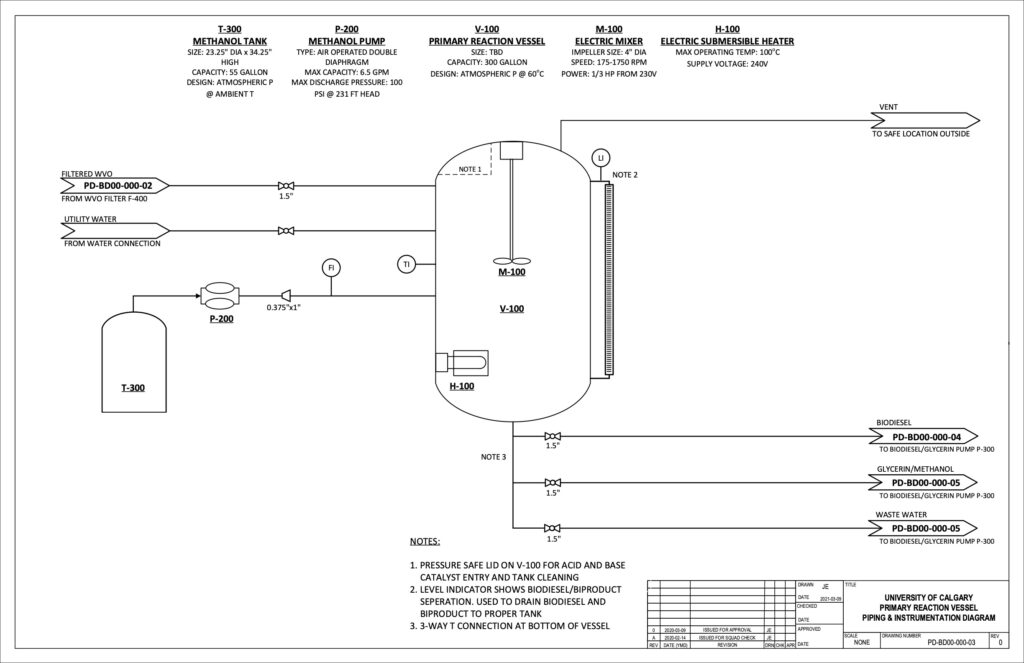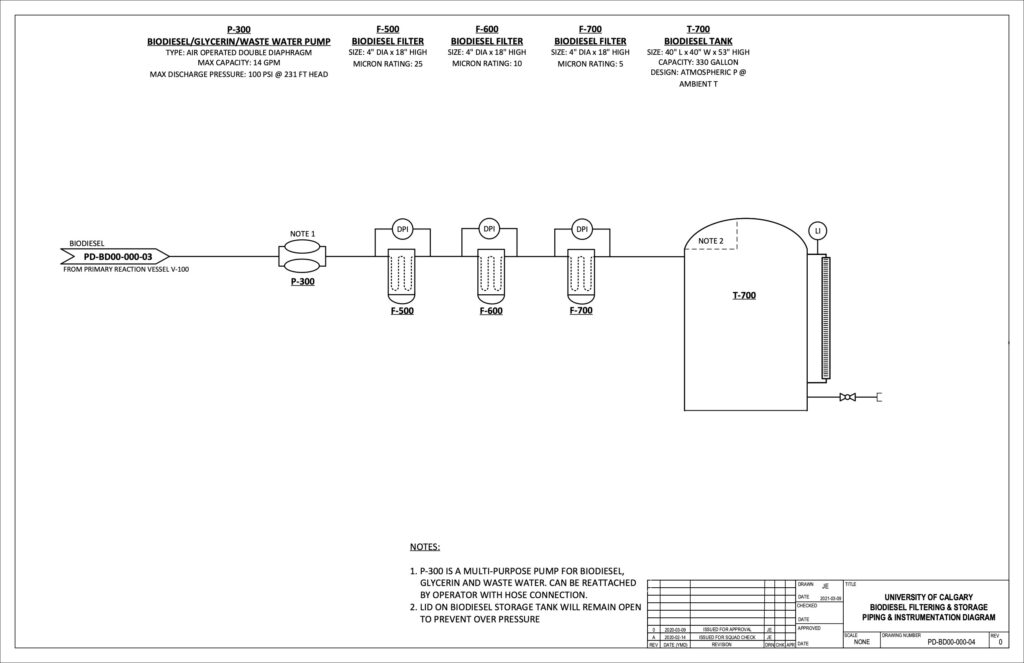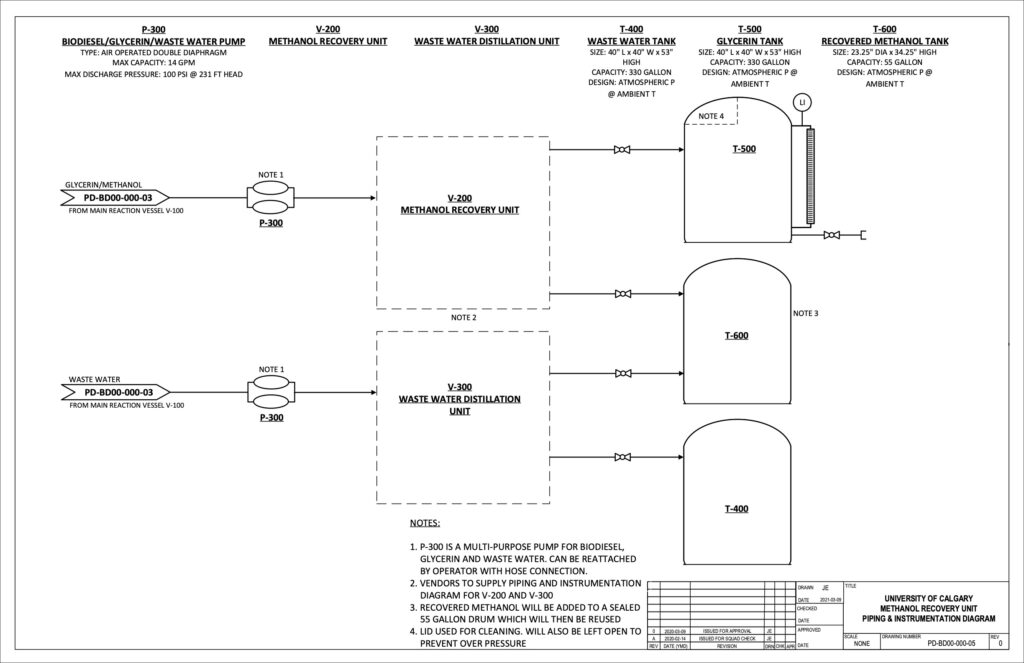Project Category: Mechanical
Join our presentation
About our project
Running the backup power generators and grounds maintenance equipment at the University of Calgary consumes 36,900L of petroleum diesel annually, resulting in high levels of carbon emissions admitted into the atmosphere at a substantial cost to the University. In addition, the University pays a third party organization to dispose of all waste vegetable oil (WVO) produced by food and beverage tenants on campus. In the 2019 fiscal year, monthly WVO production fluctuated between 440 – 2660 litres per month.
In order to offset the cost of petroleum diesel, the cost of Waste Vegetable Oil removal, and the magnitude of carbon emissions, there exists an opportunity to utilize the WVO produced on campus. The conversion of oils into high quality biodiesel via transesterification is a proven method of upcycling with great successes at small scale university operations and large industrial processes alike. Such an operation can replace a substantial fraction of the petroleum diesel used on campus all while creating carbon offsets for the University.
The below Capstone Design Team has successfully produced a conceptual design for the conversion process which ensures economic and environmental feasibility, all while accommodating the longevity of production and consumption systems currently on campus.
Meet our team members

Seth
Milner
Project Manager
Commercial Lead
Seth has taken on the Project Manager role. He has been in charge of outlining all major deliverables, which included creating a project deliverable schedule and tracking sheet. On top of the project management role, Seth has been vital in the research and development phase of the project. This is displayed by and not limited to: a major role in chemical process research, identification of necessary process equipment, and presentation of both the data and conclusions resulting from the financial analysis.

Bailey
Kimmel
Project Coordinator
Inter-Process Manager
Possessing the title of Project Coordinator, Bailey has aided in a multitude of deliverables all while documenting the teams progress through formulation and distribution of meeting minutes. His additional work as the Inter-Process Manager has required continuous evaluation of how each process in this conceptual design will interact with each other, and the necessary componentry for connection. Notable projects completed under his guidance was the thorough design of the WVO transportation system and Risk Management Matirx.
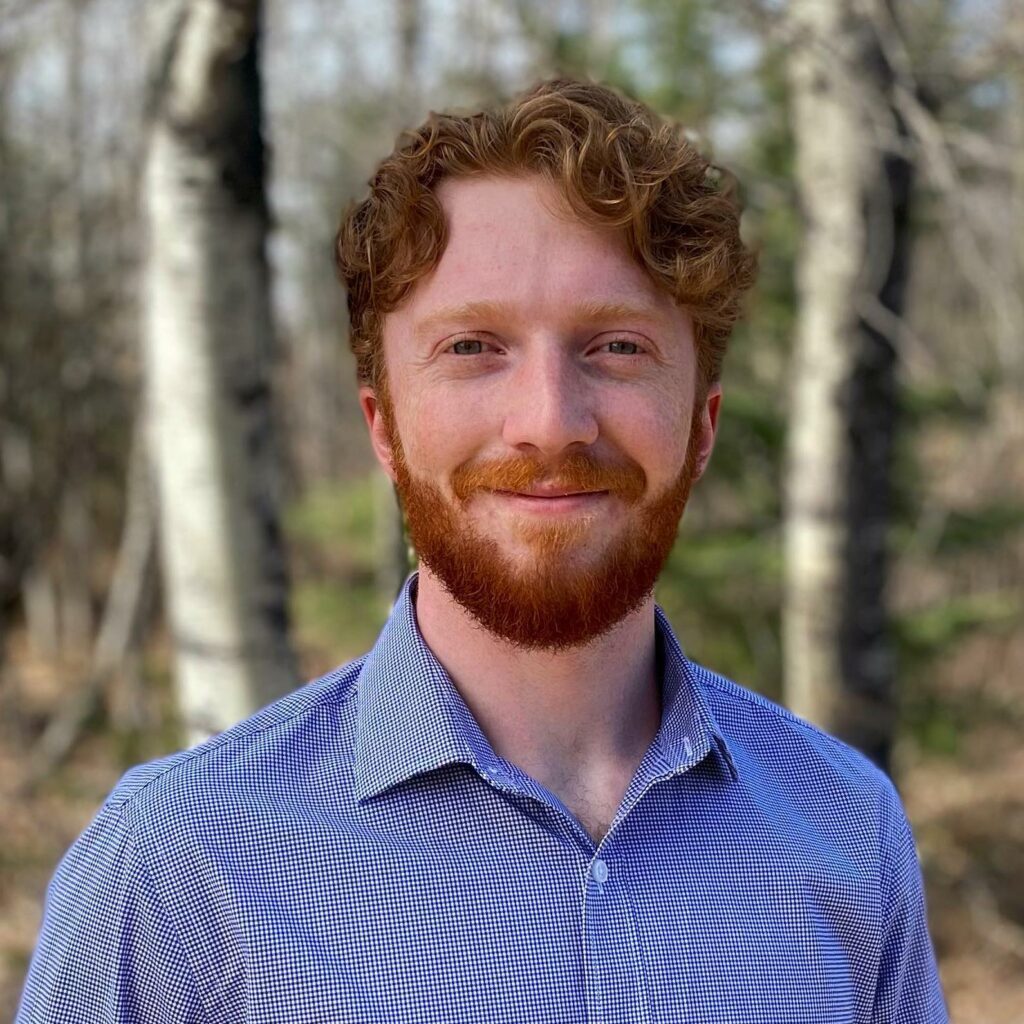
Cael
McLennan
Environmental Analyst
Production Process Lead
Cael has represented the team as the Production Process Lead when it comes to all aspects of WVO conversion to biodiesel. He completed a in-depth study on the optimal chemical conversion process as to provide the team with the most practical method that can be implemented at the University. Analyzing the current and future energy market in Alberta, Cael has also quantified the environmental impact resulting from this projects introduction.

Jacob
Elias
Director of Logistics
Quality Assurance Lead
Jacob has been named the Quality Assurance Lead, and thus, has overseen how biodiesel will be consumed on campus in a safe and environmentally conscious manner; This has grown to include what specifications must be met to ensure the biodiesel produced on campus reaches national standards and all OEM warranties for the intended machinery are met. Further defining his role as the Director of Logistics, Jacob has aided in all logistical concerns relating to production process while also creating all schematic diagrams of the conceptual design.
Details about our design
HOW OUR DESIGN ADDRESSES PRACTICAL ISSUES
Any and all practical issues pertaining to the development of a biodiesel production facility can be segregated into the following three sections:
Collection
With a varying average of 1150L/month produced on campus, WVO collection is critical to this projects success and thus the selected system must be simple, easily repairable, robust and low investment. The system selected was a Super Sucker Vacuum Pump. As a result of the mandates to replace propane tanks every 25 years, systems from retrofitted tanks can be easily fabricated, and with monthly transportation trips, theses high volume tanks accommodate the Universities maximum WVO production rates.
Conversion
The on campus production facility will consist of the following equipment for production as listed in the Process Flow Diagram below:
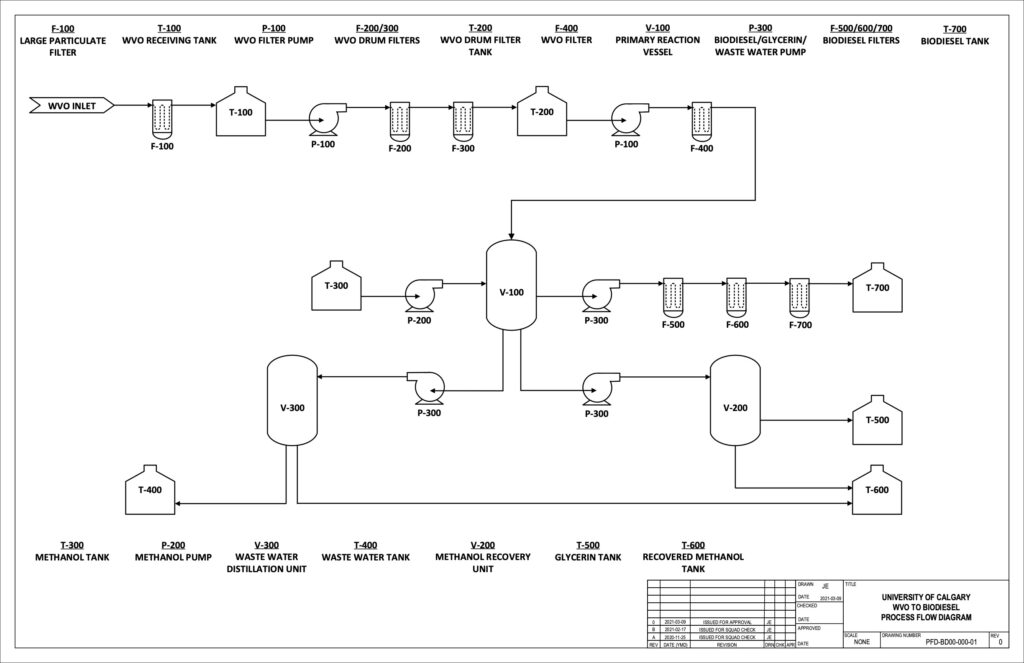
To house the production facility equipment, we found a 400sqft ventilated room with a easily accessible loading bay/garage would be viable for the safe production of biodiesel. Location is to be determined via University of Calgary Staff following project approval and dependent on available space.
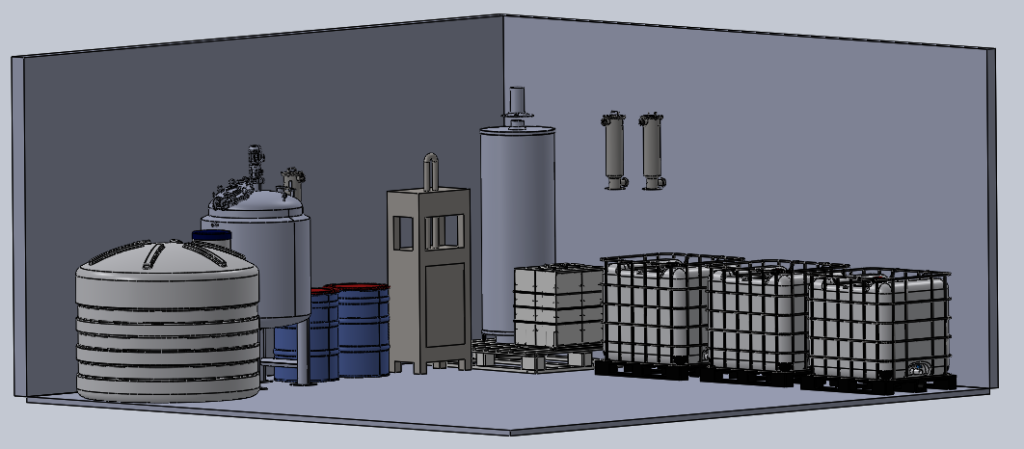
Consumption
The University of Calgary consumes roughly 3075 L of diesel fuel every month between the maintenance equipment and emergency backup generators. For the used equipment on campus, biodiesel can be blended to a maximum of 20% in petroleum diesel as to maintain warranties. With a 20% biodiesel consumption, a diesel fuel reduction of 615 L per month would be realized, leaving approximately 1300 L of produced biodiesel in excess. As the produced biodiesel will already meet ASTM D6751 standards, the remaining fuel will be offered to the public for retail sale in a effort to minimize the projects payback period while reducing the carbon footprint of local Calgarians.
WHAT MAKES OUR DESIGN INNOVATIVE
The need for a sustainable future and responsible consumerism is greater now than ever before. The implementation of biodiesel on the University of Calgary campus is innovative in itself as it reduces the campus reliance on fossil fuel based energy, ultimately contributing to the University of Calgary’s reputation as a leader in sustainability.
Our project harnessed several key components resulting in an innovative design. A methanol distillation unit was sourced to recover up to 40% of the methanol added to the reaction. A waste water filtration unit was added to reuse water and reduce the amount going to disposal. The transportation trailer will power all its componentry through a solar array and inverter to capture the sun’s energy and reduce grid reliance. Lastly, a biocide and oxidative stabilizer will be added to the biodiesel to prevent fungi growth and improve the oxidative stability. These additives increase the shelf life of biodiesel and reduce the possibility of low-quality product.
WHAT MAKES OUR DESIGN SOLUTION EFFECTIVE
Our design incorporates a modular production system. This allows for both ease of operation, and ease of maintenance. In addition, this design makes upgrading and up-scaling both possible, and uncomplicated.
We have incorporated two distillation units: one for the recovery of methanol, and the other to purify wastewater for reuse and to reduce waste. Compared to common biodiesel production designs, these distillation units increase the environmental and economic sustainability of this project.
All components comprising our production system are easily sourced, and have been chosen for simplicity of operation. Using on-campus chemistry labs for quality testing allows us to produce consistent ASTM standard-meeting biodiesel, which can be sold to market, or used on campus. Overall, this design allows for a range of options for the consumption of biodiesel.
An environmental analysis shows clear emissions reductions compared with the current petroleum diesel consumption at the University of Calgary. We can reduce up to 12,700 kilograms of carbon dioxide annually in addition to the CO2. reduced by selling the additional biodiesel to the public.
Our cost-effective, environmentally conscious biodiesel production system will allow the University of Calgary to reduce waste and emissions, and produce long-term revenue for use in operations around campus. We believe that our project will fortify the university’s position as a leader in sustainable operations.
HOW WE VALIDATED OUR DESIGN SOLUTION
The Capstone Design Team was thankful to have numerous University ran biodiesel production facilities across North America from which the conceptual design could be validated against. Most notably, the biodiesel production facilities at the University of British Columbia (UBC) and University of Idaho served as the two benchmarks from which our design was compared against.
The University of Idaho has a impressive and historic biodiesel education/production facility. Beginning their research in 1979, the University has continually produced and experimented with various biodiesel processes and began educating both in house and online in 2013 on the science behind biodiesel. The work completed by the Biodiesel Education Program is clear, concise, and a source of optimism for the future of biodiesel in North America.
https://www.biodieseleducation.org/index.php
With a more recent start date, the UBC production facility began in 2012. Beginning as pilot project from which the products were used on campus, the facility is moderately sized, sells a portion of their product and served as a excellent comparison for our proposed design.
http://blogs.ubc.ca/sustainabilityclub/biodiesel-project/
While it was hope inducing seeing the above projects in operation, a commonality for their successes was a dedicated support staff, something which the University of Calgary currently does not posses.
FEASIBILITY OF OUR DESIGN SOLUTION
The entire scope of this project has been focused on determining the feasibility of implementing a waste vegetable oil to biodiesel conversion process on the University of Calgary campus. And can it be done? In a word, yes. Examining this project from technical, environmental, and commercial standpoints, our overarching conclusion is that it is feasible to implement such a system at the University of Calgary.
We began by first researching the technical feasibility, investigating the chemical process and designing a production process. Although many people create biodiesel in their “backyard”, we needed to ensure that our process met ASTM standards. After extensive research, we were able to design a biodiesel production system that could reasonably be implemented on campus, and could meet the highest standards of quality. Having done this, we then examined the environmental and economic benefits of such a project.
We concluded that implementation of this project would result in a reduction of thousands of kilograms of CO2 released into the atmosphere every year. It would reduce the carbon footprint of the University, and improve our reputation as a leader in sustainability. The economics look equally optimistic:

Our commercial analysis showed us that payback of the capital expenditure necessary to implement this project could be possible within a decade. We believe that this could be an exciting opportunity for the University of Calgary, and could put us on the map as an innovator in sustainable resources.
Partners and mentors
Our group would like to express our immense gratitude for our project sponsors; Ana Pazmino, the coordinator of recycling and solid wastes at the U of C; and Earl Badger, the associate director of energy and utilities at the U of C. Without their interest in pursuing this project, we would not have had the opportunity to broaden our horizons into sustainability at the University of Calgary. In addition, they have continually been available for our inquires and provided us with the contacts of Harry Friesen, Grounds Supervisor for the U of C; Lee Ferrari, senior manager of fleet and municipal services for the U of C; Tim MacEachern, power generator technician; Brian Baillie, research laboratory ICPMS/MS technician; and Angel Chung, Hazard Materials Technician. All the above have contributed and immeasurable amount to this project that has and will continue to be appreciated by our group.
Lastly, we would like to thank Dr. Simon Li and Min-Hyung Lee, our course instructor and grading TA for their time and dedication to this course. Dr. Li has been present and interested in our group meetings throughout the semester, and we appreciate his continued interest in our project and its results.
Our photo gallery
Research and Development Media
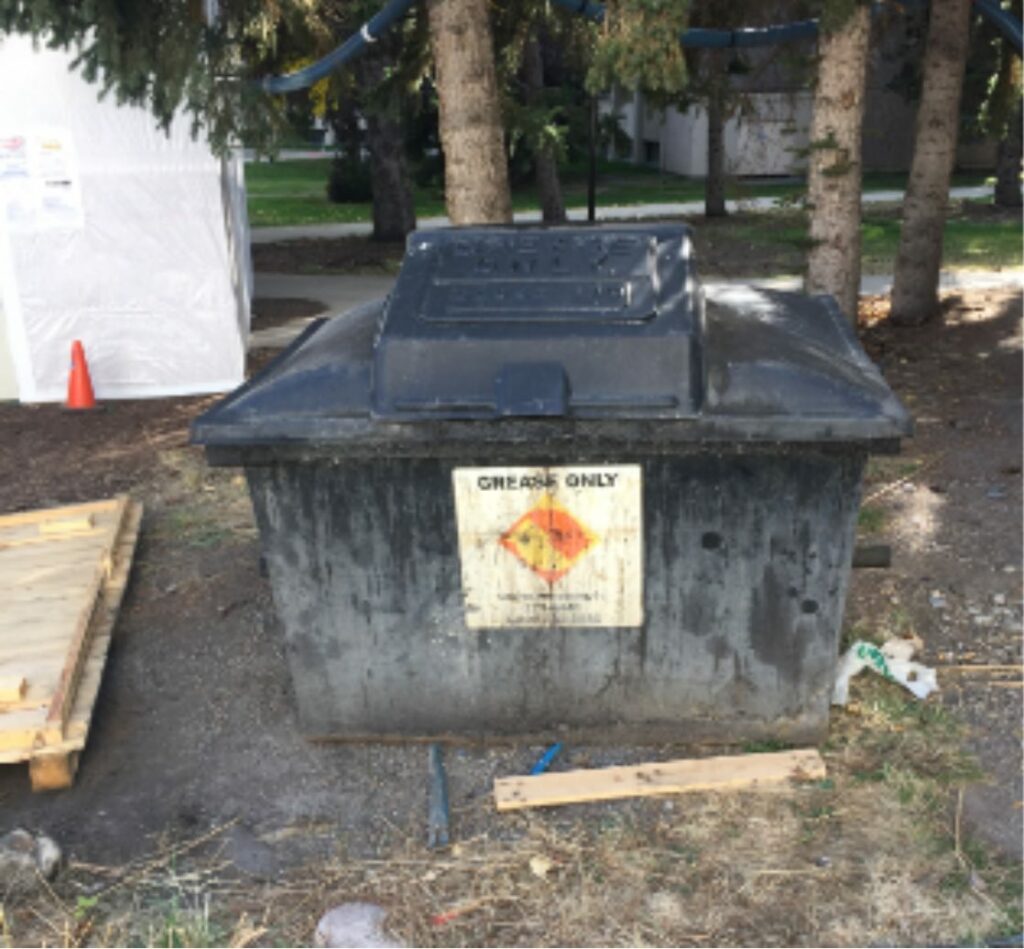
WVO Storage Bin outside University of Calgary Dining Centre 
WVO Collected at the University of Calgary from April 2019 to March 2020 
Example of a trailer mounted Super Sucker Vacuum Pump for WVO transportation 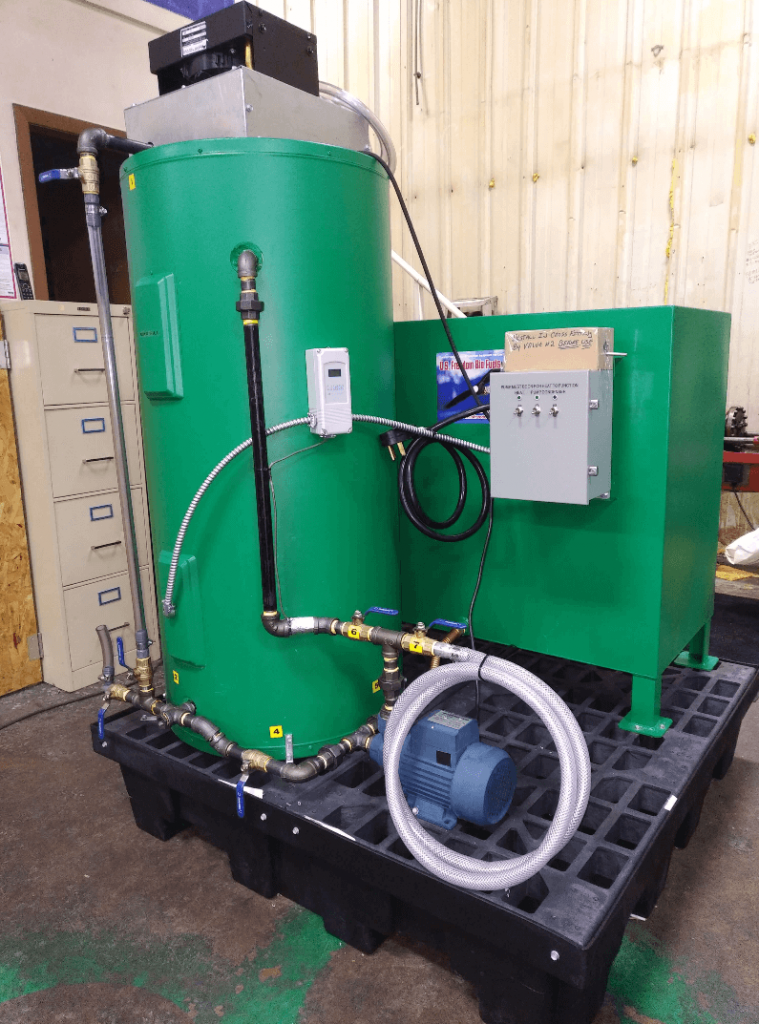
Methanol Recovery System https://usfreedombiofuels.com/methanol-recovery-system/ 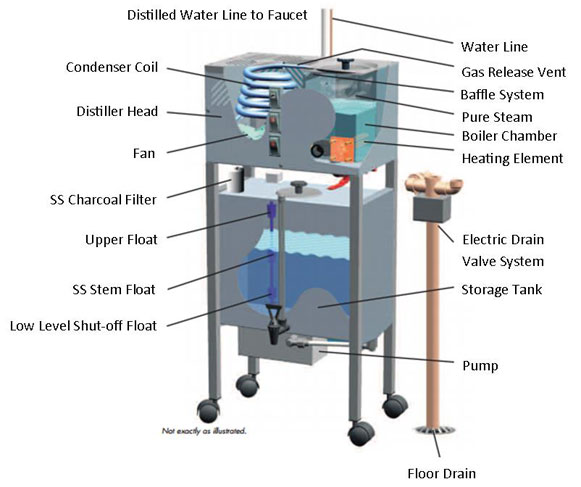
Water Distillation Unit https://ritechwatersystems.com/industrialdistillationsystems.html 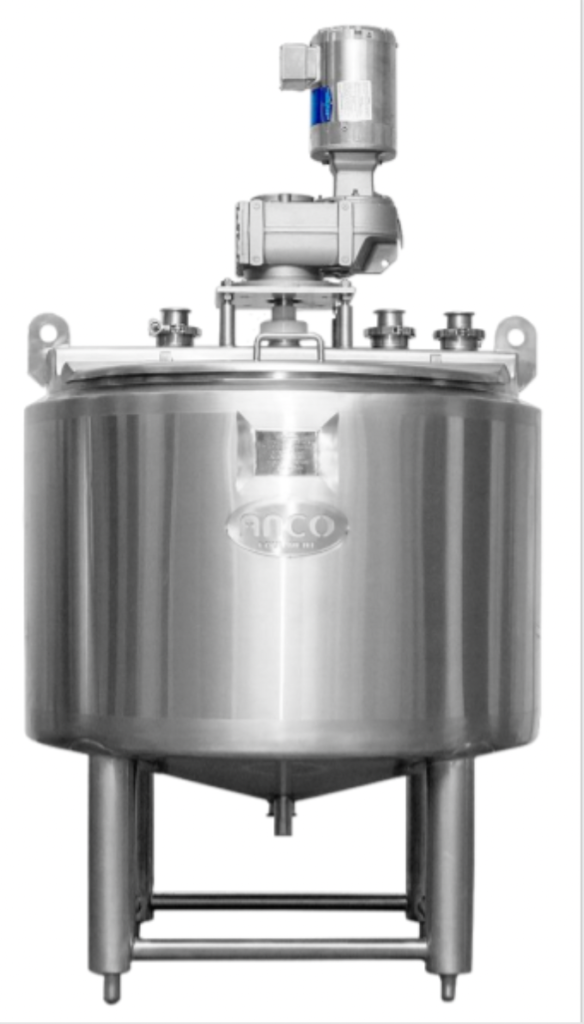
Reactor Vessel https://www.ancoequipment.com/stainless-steel-process-tanks 
Proposed Production Facility Visualization 1 
Proposed Production Facility Visualization 2 
Proposed Production Facility Visualization 3
